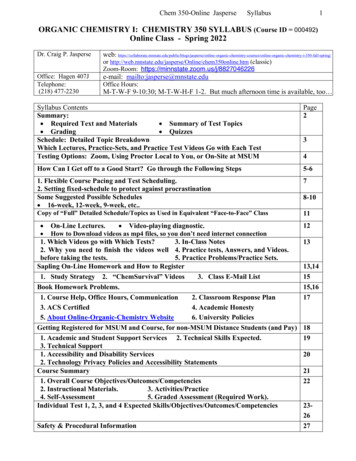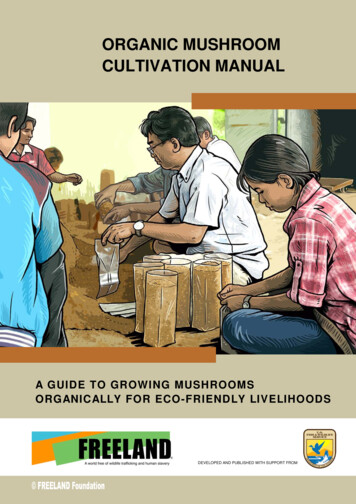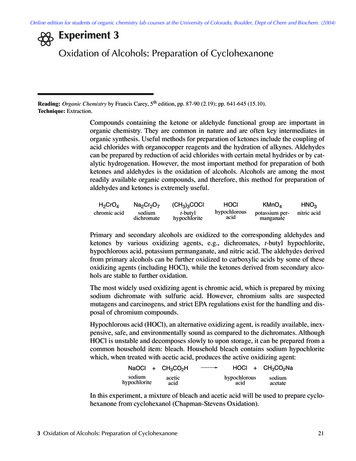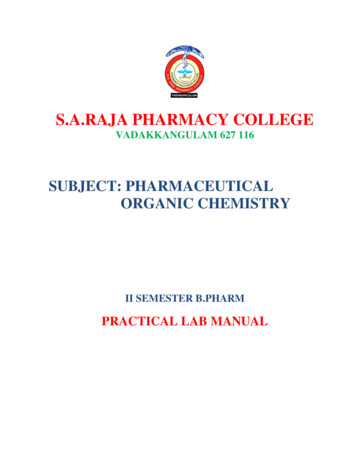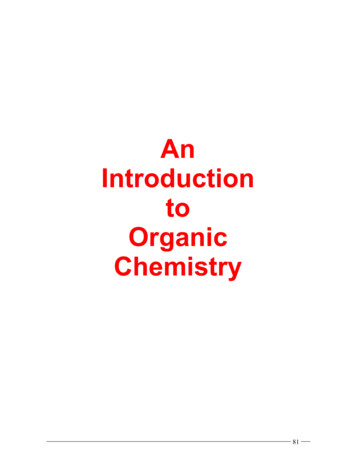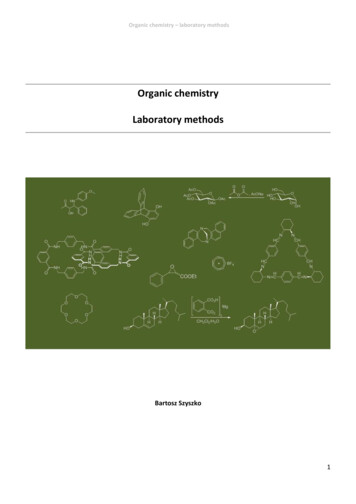
Transcription
Organic chemistry – laboratory methodsOrganic chemistryLaboratory methodsBartosz Szyszko1
Organic chemistry – laboratory methodsOrganic chemistry – laboratory methodsDescriptionThis course deals with laboratory techniques in organic chemistry laboratory. Upon successful completion of this coursestudents will posess practical skills required for work in modern chemical ageEnglishPrerequisitesbasic organic chemistryTime commitment90 hours; 5 preparatory sessions (30 hours) and 7 regular sessions (60 hours)Learning objectives1. Purification and drying organic solvents and reagents by distillation in an inert and moisture-free atmosphere.2. Microscale synthesis.3. Running a reaction for a long time (also under reflux).4. Synthesis under moisture- and air-free condtions.5. Running a reaction at low temperature.6. Performing multi-step synthesis without isolation of the intemediates.7. Isolation of the product from a mixture containing very reactive reagents.8. Isolation of the product by distillation, crystallization and chromatography.9. Using Schlenk line. Removing solvents with high vacuum. Performing a vacuum distillation (also fractional) and bulb-to-bulbdistillation.Calendar and class meetingsBefore start of the course all the students will participate in the fire-fighting training provided by specialized Fire-Fighters. Dateof the training will be provided in near future.wednesday, 1100-1700class123456date2 XI9 XI16 XI23 XI30 XI7 XIIclass789101112date14 XII 20164 I 201711 I 201718 I 201725 I 20171 II 2017InstructorsDr. Bartosz Szyszkobartosz.szyszko@chem.uni.wroc.ploffice 1066 (1st floor, Biotechnology Department)phone no. 48 71 375 7392Dr. Halina ce 2035, 2043 (2nd floor, Biotechnology Department) 48 71 375 7637Office hoursBartosz Szyszko: Tuesday, Thursday 1015-1115 or by appointmentHalina Zhylitskaya: Monday, Wednesday, Friday 1100-1200 or by appointment2
Organic chemistry – laboratory methodsGrading and Rules of evaluationThe final grade will be weighted arithmetic mean of two grading elements: (1) lab work (60%) and (2) post-lab reports (40%) lab work will be graded twice – after 4th and 8th class; the lab work grade will be an arithmetic mean of those twogrades post-lab reports will be graded seven times – every time the report will be sumbitted; the post-lab reports grade willbe an arithmetic mean of those seven gradesThe lab work grade will be based on: following the safety regulations and good work practices in chemical laboratory punctuality (starting and finishing the lab work on time) preparation for the class, theoretical knowledge of experimental techniques that will be used in the experiment a proper planning of the activities in time tidiness of the work space the proper use of glassware and equipment independence in the lab work knowledge of the proper disposal of chemical waste the proper conducting of notes from lab workPlease note that not-following the Safety Regulations will result in a low grade from the lab work!The post-lab reports grade will be based on: punctuality – the report should be submitted maximum 14 days after the class; reports submitted after 14 days willbe given 2.0 grade completeness of the report and correctness of the physicochemical data that must be provided for thecharacterization of each compound completeness and correctness of the answers provided for post-lab questions; correctness of literature citation each report will be graded only oncePreparation for the classBefore starting the class all students must: carefully read the experimental procedure for the experiment identify all the potential hazards that might appear during the experiment and find a way to prevent them and dealwith them read the Material Safety Data Sheet (MSDS) for each reagent that will be used during the experiment think of and prepare a sketch of the glassware set and equipment that will be used during the experiment; this willbe discussed with the Instructor and should be modified according to Instructor’s suggestions plan all of the activities in time (and write them down in points) learn about a proper way of disposal of chemical waste generated during the experiment get acquainted with instructional video materials related to the experimental techniques that will be used in theexperimentRecommended textbooks1. J. C. Gilbert, S. F. Martin, “Experimental Organic Chemistry. A Miniscale and Microscale Approach”, Thomson 20062. A. I. Vogel, A. R. Tatchell, B. S. Furnis, A. J. Hannaford , P. W. G. Smith “Vogel’s Textbook of practical organic chemistry”,Prentice Hall 19963. J. Gawroński, K. Gawrońska, K. Kacprzak, M. Kwit “Współczesna synteza organiczna – wybór eksperymentów”, WydawnictwoNaukowe PWN 20044. J. K. Swadesh (Ed.) “HPLC. Practical and Industrial Applications”5. J. W. Zubrick “The Organic Chem Lab Survival Manual”, Wiley 20106. L. M. Harwood, C. J. Moody, J. M. Percy “Experimental Organic Chemistry, Standard and Microscale”, 2nd ed., BlackwellScience 19997. P. G. M. Wuts, T. W. Greene “Greene’s Protective Groups in Organic Synthesis”, any edition, Wiley & Sons8. W. L. G. Armarego, C. L. L. Chai, “Purification of Laboratory Chemicals” any edition, Elsevier9. C. F. Wilcox, „Experimental Organic Chemistry, A Small-Scale Approach”, MacMillan Publishing Company, New York 19883
Organic chemistry – laboratory methodsSafety Rules in the Organic Chemistry Laboratory1. When working in the Organic Chemistry Laboratory you should remain calm and behave properly. All students are resposiblefor the tidiness of their work environment.2. Wearing lab coat and the proper eye protection is obligatory. When working with corrosive reagent it is obligatory to wearprotective gloves.3. Wearing contact lenses during the lab work is not recommended. Pregnant women cannot take part in organic chemistrylab classes. Students who suffer from the chronic diseases like epilepsy or allergies are obligated to inform the Instructor aboutit.4. All students need to have a lab book for making notes during experiments. All the products of syntheses should be given tothe Instructor in the end of the class following by the post-lab report. This is obligatory for a successfull completion of thecourse.5. Only diluted solutions of acids and bases might be disposed in a sink. The concentrated solutions of acids and bases shouldbe diluted prior the disposal. All of the organic solvents have to be transferred into the appropriate container, which is locatedunder the special fume hood. Students will be instructed how to dispose different types of liquid and solid waste. It is notallowed to put any solid waste into the sink.6. All lab work with organic reagents and solvents must be performed under the fume hood.7. Students must be extremely cautious when working with concentrated solutions of acids, bases, flammable liquids (diethylether, acetone, alcohols, benzene and other organic solvents), bromine and toxic reagents.8. Any type of emmergency or dangerous situation should be immediately reported to the Instructor who will provide the firstaid.9. In the case of fire students should remain calm, switch off electricity sources and remove the flammable materials from thearea covered with the fire. To fight the fire you should use a proper fire extinguisher or a fire blanket. Covering the burningarea with a wet towel might stop small fire. In the case of any fire it is absolutely necessary to report the incident to theInstructor.10. Burning people should be toppled to the floor and covered with a blanket fire or doused with water. You musn’t use a fireextinguisher to fight a fire on a burning person.11. It is not allowed to:a) pipet with your mouth, b) use flammable solvents in the close proximity to the source of fire or heat, c) eat or tastechemicals, d) run the experiments that are not included in the lab schedule.12. In the laboratory you mustn’t:a) smoke cigarettes, b) eat or drink, c) leave any apparatus unattended, d) leave the lab without informing the Instrutor, e)bring other people, f) bring the jackets, coats or bags of any type.13. This is the obligation of a student on a duty (picked by the Instructor) to bring, take care and return the special equipmentfrom the lab Technicians. This student is also responsible for taking care of the tidiness of the laboratory during the class andwhen the class finishes. The student on a duty will leave the laboratory, as the last person once the lab Technicians will approvethe tidiness of the laboratory.14. Students are financially responsible for the equipment and glassware.15. Students will confirm that they have read and understood the Safety Rules by signing its copy.4
Organic chemistry – laboratory methodsAccidents in the lab and first aidBurnings caused by heat, acids, anhydrides, alkalines and bromineAffected area of the body should be thoroughly washed with a copious amount of running water (wash it for at least 30minutes). Cover the area with a sterile bandage. If the chemical affected a large area of the body call the ambulance as soonas possible (phone no. 112 or 999).Burnings caused by phenol and other organic reagentsIf the chemical that caused the burning does not react with water the affected area of the body should be thoroughly washedwith a copious amount of running water (wash it for at least 30 minutes).Burnings caused by sodiumIf there are still pieces of sodium on the skin they should be carefully removed with tweezers and then the affected area of thebody should be thoroughly washed with a copious amount of running water (wash it for at least 30 minutes). Cover the areawith a sterile bandage.Acids, anhydrides, alkalines or bromine in the eyeThe eye should be thoroughly washed with a copious amount of running water using an eye-wash (wash it for at least 30minutes). The eye should be covered with a sterile bandage. Call the ambulance as soon as possible (phone no. 112 or 999).Burning clothesYou shouldn’t allow the burning person to run. Burning people should be toppled to the floor and tightly covered with a fireblanket or doused with water. You musn’t use a fire exinguisher to fight a fire on a burning person.Burning chemicalsSwitch off all of the electricity and gas sources in the neighborhood of fire. Remove all the flammable materials from the areacovered with fire. Covering the burning area with a wet towel might stop small fire. To fight the larger fire you should use aproper fire extinguisher or a fire blanket. In the case of any fire it is absolutely necessary to report the incident to the Instructor.Emergency phone numbers112999998 48 71 375 7298Mobile phonesEmergency medicalservicesFire FightersConcierge in ChemistryDepartment5
Organic chemistry – laboratory methodsInstructional video materialsWhen preparing for the class all students must get acquainted with the experimental techniques that will be used during theexperiment. The Instructor will evaluate theoretical knowledge of those techniques during the class.In order to learn a new technique or to refresh knowledge of known method it is required to read a proper chapter in one ofthe recommended textbooks or, and this is recommended solution, to watch the proper video material.Links to the appropriate materials are collected and linked below. Please let me know if any of those links do not work – in thiscase you will obtain the appropriate materials from the Instructor.Using lab equipment and basic experimental techniquesUsing a balancehttps://www.youtube.com/watch?v cG6QrqS4ruQ&index 11&list PLB208D0FA80AD438FMagnetic stirrershttps://www.youtube.com/watch?v NeDgBuNoOAg&list ube.com/watch?v zTTbwFA ftghttps://www.youtube.com/watch?v jzzDixOGmgkhttps://www.youtube.com/watch?v 4Fvpj fN7zAhttps://www.youtube.com/watch?v jX36MWprjp4&list PLBD8CDADC266F3BDC&index 6Using an automatic pipettehttps://www.youtube.com/watch?v AcNtVgOp0bI&list PLB208D0FA80AD438F&index 13Using a rotary evaporatorhttps://www.youtube.com/watch?v yDP5NycfCdc&index 19&list PLjPjM i9bhFTh uzicV oAbYTFCGp-8Phttps://www.youtube.com/watch?v HSZJcv8fg5chttps://www.youtube.com/watch?v ug2Qz-Y71jQ&list ube.com/watch?v 3DQj4dibr78&index 6&list PLB208D0FA80AD438FFolding fluted filter paperhttps://www.youtube.com/watch?v hY3XuXa0YuEhttps://www.youtube.com/watch?v ykmTxRpRRCwGravity and vacuum filtrationhttps://www.youtube.com/watch?v fFdvEgg1t14https://www.youtube.com/watch?v AiYnnpVUbywExtraction and using simple drying agentshttps://www.youtube.com/watch?v kdsZjeywrTkhttps://www.youtube.com/watch?v 66QmPP0vlukhttps://www.youtube.com/watch?v DmvaOb1xb1o&list PLB208D0FA80AD438F&index 5Acid-base extractionhttps://www.youtube.com/watch?v Tn0P2x0X vsCrystallization, recrystallizationhttps://www.youtube.com/watch?v 7LBGQHjgHEw&list PLB208D0FA80AD438F&index 9https://www.youtube.com/watch?v h?v dBNELFi5XiY&list PLB208D0FA80AD438F&index 86
Organic chemistry – laboratory methodsSimple distillationhttps://www.youtube.com/watch?v GtuMlWMajtw&index 15&list PLB208D0FA80AD438Fhttps://www.youtube.com/watch?v rpxtV2v2zuAFractional distillationhttps://www.youtube.com/watch?v iB6HHuzfadwVacuum distillationhttps://www.youtube.com/watch?v mn-u-7fRQv4Microdistillation using a Hickmann still headhttps://www.youtube.com/watch?v 46gqI90ELuUhttps://www.youtube.com/watch?v UT5mPJTpOyQhttps://www.youtube.com/watch?v 4k8Re3FlyuERefluxhttps://www.youtube.com/watch?v fHEk2WFgmXQ&index 17&list PLB208D0FA80AD438FThin Layer Chromatography TLChttps://www.youtube.com/watch?v iV1GfI BbKEhttps://www.youtube.com/watch?v e99nsCAsJrw&index 3&list PLB208D0FA80AD438Fhttps://www.youtube.com/watch?v ml58GCq078o&index 4&list PLB208D0FA80AD438FColumn chromatographyhttps://www.youtube.com/watch?v B QyhG2-VBI&index 10&list PLB208D0FA80AD438FFlash chromatographyhttps://www.youtube.com/watch?v fF1gXUvyGb4https://www.youtube.com/watch?v ci2uu9Cuf5sNMR sample preparationhttps://www.youtube.com/watch?v Sov0x9YdVfghttps://www.youtube.com/watch?v 3JxE AwPD14Air- and moisture-sensitive reagents, vacuum techniquesDrying glassware, using a heat-gunhttps://www.youtube.com/watch?v 4O65iU0N89whttps://www.youtube.com/watch?v 9G7-Rc4lBcsDrying molecular sieveshttps://www.youtube.com/watch?v CmKGt92oMYUUsing solvent still headshttps://www.youtube.com/watch?v 7IDlnuu-0QEVacuum distillation of solvent under moisture- and air-free conditionshttps://www.youtube.com/watch?v eVajSoZEr-kBulb-to-bulb distillation, using Kugelrohrhttps://www.youtube.com/watch?v o34psrncdB87
Organic chemistry – laboratory methodsUsing Solvents Purification System (SPS)https://www.youtube.com/watch?v n9Kfj8pmClAUsing a glove-boxhttps://www.youtube.com/watch?v IpTc-qcNPgYUsing Schlenk linehttps://www.youtube.com/watch?v Eov60kI7yw8https://www.youtube.com/watch?v my1YR35W7Cohttps://www.youtube.com/watch?v -5xtZs3jPegDegassing solvent on the Schlenk linehttps://www.youtube.com/watch?v SEVzJp901noDegassing solvents, freeze-pump-thaw methodhttps://www.youtube.com/watch?v GpbXTk9VbBgInert atmosphere techniques, using cannulahttps://www.youtube.com/watch?v 9npHPE6PhSIhttps://www.youtube.com/watch?v DSoFRyQTsHcWorking with pyrophoric liquidshttps://www.youtube.com/watch?v 21iC4YEgOAshttps://www.youtube.com/watch?v 3 cBVfYVAC8https://www.youtube.com/watch?v WUHrzcEunNYWorking with reactive metalshttps://www.youtube.com/watch?v ozmddj0fIpkWorking with n-buthyllithiumhttps://www.youtube.com/watch?v M3Av0UjSWpAhttps://www.youtube.com/watch?v ojBqqnqJalsWorking with Grignard reagentshttps://www.youtube.com/watch?v s3sShnm1ArMVarious vacuum techniqueshttps://www.youtube.com/watch?v -5xtZs3jPeghttps://www.youtube.com/watch?v quO0pwX56w8https://www.youtube.com/watch?v XIuIRdXsEw48
Organic chemistry – laboratory methodsList of experiments2A Purification of n-hexane .182 B Distillation of thiophene .192B Distillation of N,N,N',N'-tetramethylethylenediamine (TMEDA) .202C Distillation of pyridine .212D Distillation of triethylamine .222D Distillation of methanol .232A Synthesis of the catalyst for Glaser-Eglington-Hay coupling.242C Synthesis of Wilkinson's catalyst .253.1A Asymmetric synthesis of ethyl (S)-3-hydroxybutanoate with the use of baker's yeast (1) .263.1B Asymmetric synthesis of ethyl (S)-3-hydroxybutanoate with the use of baker's yeast (2) .283.1C Synthesis of 1-amino-3-nitrobenzene with the use of baker's yeast .293.2A L-Proline catalysed asymmetric synthesis of aldoles from acetone .303.2B L-Proline catalysed asymmetric synthesis of aldoles from hydroxyacetone .313.2C L-Proline catalysed synthesis of Mannich's bases from hydroxyacetone .323.3A Interphase oxidation of alcohols with NaOCl catalysed by quaternary ammonium salts .333.3B Interphase Darzens reaction - synthesis of ethyl 3-phenyloxirane-2-carboxylate catalysed by crown ether .343.4A Reduction of carvone to 7,8-dihydrocarvone catalysed by Wilkinson's catalyst .353.4B Olefin metathesis - synthesis of methyl ester of (E)-methyl 3-(4-chlorophenyl)acrylate .364.1A Synthesis of p-nitroaniline from aniline based on protection/deprotection of amine group .374.1B BOC-protection of amine group of aminoacid .394.1C Protection of hydroxyl groups of carbohydrate .404.1D Protection of carbonyl group - synthesis of 1,3-dioxolane from ethyl acetylacetate .414.2A Synthesis of ethyl phenylpyruvate .425.1A Diels-Alder reaction - synthesis of dihydroxytriptycene .445.1B Diels-Alder reaction - synthesis of 2,3-dimethyl-buta-1,3-diene and its reaction with maleic anhydride .465.1C Claisen rearrangement - synthesis of 2-allylphenol .485.2A Synthesis of benzyne and its reaction with furan .495.2B Addition of carbene to alkene under PTC conditions .505.2C Synthesis and properties of stabilized carbocations .515.2D Free radical addition to -pinene - synthesis of 7-trichloromethyl-8-bromo- 1-p-menthane .525.2E Peracid epoxidation of alkene .536A Suzuki cross-coupling - synthesis of unsymmetrical biaryls .546B Sonogashira coupling - synthesis of 1-nitro-4-(phenylethynyl)benzene .566C Heck coupling - synthesis of cynammic acid .586D Glaser-Eglington-Hay coupling - synthesis of 1,1'-(buta-1,3-diyn-1,4-diyl)dicyclohexanol .597A Grignard reagents - synthesis of phenylmagnesium bromide and its reaction with ethyl 3-oxobutanoate ethylene ketal .617B Diisobutylaluminium hydride (DIBAL-H) - reduction of butyrolactone .637C Organolithium reagents - synthesis of 2,5-bis(tolylhydroxymethyl)thiophene .657D Organophosphorus reagents - 4-vinylbenzoic acid from Wittig reaction in aqueous medium .677E Organophosphorus reagents - p-methoxystilbene from Wittig reaction .688A Mechanochemical synthesis of racemic 1,1'-bi-2-naphthol and 2,3-diphenylquinoxaline.698B Macrocyclic compounds - synthesis of trianglimine .708C Macrocyclic compounds - synthesis of p-tert-butylcalix[6]arene .718D Template synthesis - synthesis of copper(II) phthalocyanine .728E Mechanically interlocked molecules - synthesis of [2]catenane .738F Chiral compounds - synthesis and deracemization of Tröger's base controlled by optical rotation measurements .749
Organic chemistry – laboratory methodsLabeling of NMR samplesPreviously prepared NMR samples should be properly described using labels. The empty spots should be fulfilled following theexample below.In our case:KOD UŻYTKOWNIKA: SOKOD PRÓBKI: experiment number-initials-/fraction number.For example:John/Joan Smith was running experiment no. 4.1D and obtained three fractions from fractional distillation. Their NMR samplesshould be labeled as follows:4.1D-JS/14.1D-JS/24.1D-JS/3ROZPUSZCZALNIK: solvent used for sample preparation, in our case it will be most likely chloroform-d or dmso-d6.WIDMO: 1H 1m for most samples, 1H 15m when the product’s concentration is very lowChecking the status of the sampleThe NMR samples that have been submitted by the technician appear in the on-line version of NMR experiments queue.You can check the status of your experiment on the queue tmusing following informations: login – icon, password – will be provided by the Instructor10
Organic chemistry – laboratory methodsThe queue interface looks as in the example below:If the experiment that we are interested in has the Queued status, it means the sample is still waiting to be measured, whilethe Completed status, it means the spectrum has been collected and the sample was returned.11
Organic chemistry – laboratory methodsAnalysis of the spectrumOnce the 1H NMR spectrum has been recorded students need to analyze the data.The TopSpin software is recommended for processing and analyzing the NMR data. The software is available on the computersin the computer room no. 16 (next to NMR lab) whenever the room is not occupied by other classes.In order to access data you should log in to Windows using following informations:login: sopassword: Synteza1Students might also use any other free software available in Internet, e.g. nload/).Before you start analyzing the spectrum you should identify and calibrate the residua solvent signal.For chloroform-d: 7.24 ppm, dichloromethane-d2: 5.32 ppm, dmso-d6: 2.50 ppm.The analysis of the spectrum should include:1) Identification and assignment of the signals of the reaction product, including: multiplicity, coupling constants,chemical shifts, integrations, signals assignment2) Identification of the main impurities present in the samples.3) Evaluation of the purity of different fractions/batches of crystals, based on the comparison of their spectra4) Suggestions on further separation/purification based on the type of impurities present in the samples.The linked article discusses the spectroscopic data for most commonly present in organic samples impurities:Zanieczyszczenia w próbkach NMR12
Organic chemistry – laboratory methodsPressure-temperature nomographWeb source: http://www.sanpedrofarmacia.com/modules/com docman/nomograph-1931.html?nomograph-1931Date of access : 4.10.201613
Organic chemistry – laboratory methodsTable of properties for common solventsrozpuszczalnikacetic butanonet-butyl alcoholcarbon -dichloroethanediethylene glycoldiethyl etherdiglyme (diethylene glycoldimethyl ether)1,2-dimethoxyethane (glyme, DME)dimethylformamide (DMF)dimethyl sulfoxide (DMSO)1,4-dioxaneethanolethyl acetateethylene Hexamethylphosphoroustriamide (HMPT)hexanemethanolmethylt-butylether (MTBE)methylene entanePetroleum ether ran (THF)toluenetriethyl aminewaterwater, 106.1274.12Boilingpoint( 0.783.524634.5Meltingpoint( ensity(g/mL)Solubility inwater miscible0.080.050.795 25)12.3(25)7.522.38(25)2.478.54?2.572.372.27Web source: http://murov.info/orgsolvents.htm#TABLE%202Date of access: 4.10.201614
Organic chemistry – laboratory methodsEluotropic series of oroethanetoluenechloroformdichloromethanediethyl etherethyl acetateMethyl t-butyl opanolmethanolEluent 510.520.530.530.600.7015
Organic chemistry – laboratory methodsIntroductory meeting1A Organizational informationA brief description of the course, the lab schedule, the rules of evaluation and all details related to pre-lab assignments andpost-lab reports will be provided.1B Safety work practices in organic labThis part of the class will take the form of workshops and a discussion about safe practices in a chemical laboratory.We will discuss the Safety Regulations and good practices in running chemical experiments. We will also discuss how to choosea proper Personal Protective Equipment (PPE) for the experiment. Students will learn about localization and proper use of eyewashes, fire extinguishers, fire blankets and water courtains.In order to prepare for the class all students need to watch the following, short video-materials related to safety in chemicallaboratories. We will discuss them during the class.General remarkshttps://www.youtube.com/watch?v kDxrQkOKUdIhttps://www.youtube.com/watch?v E836nc7SjiICommon mistakes and preventionhttps://www.youtube.com/watch?v aA8mC5RIj5khttps://www.youtube.com/watch?v YdYapyzJNsEh
Organic chemistry – laboratory methods 3 Grading and Rules of evaluation The final grade will be weighted arithmetic mean of two grading elements: (1) lab work (60%) and (2) post-lab reports (40%) lab work will be graded twice – after 4th and 8th class; the lab


